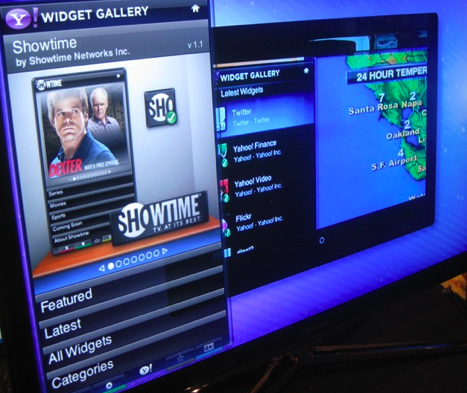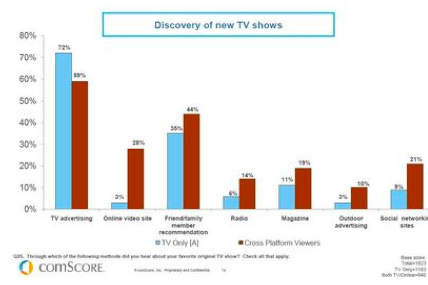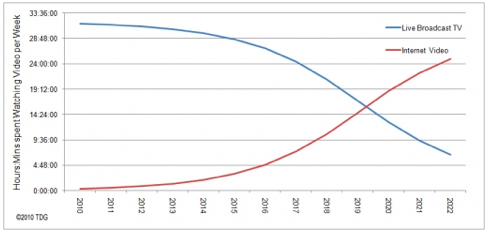Trends in online video and traditional TV
Recent studies show that viewing online videos at home is increasing. The reason is the increase in the speed of Internet access in people's homes.
More and more software and hardware solutions are appearing that make it easy and convenient to watch online videos and use the Internet on your home TV (set top boxes, Google TV, Yahoo Connected TV, etc.)

A picture of the Yahoo Connected TV interface
')
The amount of time that viewers spend watching traditional TV is growing all over the world, including the USA. Also, according to comScore, the amount of time users spend watching videos online is increasing from 3.9 to 8.3 hours per month or by 115% from July 2008 to July 2009.
According to Nielsen Co. and US Bureau of Labor Statistics, the total amount of time that the audience spends watching videos on all screens, remains almost unchanged (given in the study of The Diffusion Group). Nielsen Co. notes an increase in the simultaneous use of several media (research conducted in the USA) - 34% of respondents use the Internet while watching TV (14% more than in 2008):

It would seem that the statements “the number of hours of watching TV is growing” and “the amount of time watching all videos remain stable” contradict each other, but the fact is that most of the videos that are watched online are cinema and TV content should not be forgotten. that TV viewing and simultaneous use of a computer (including for watching videos) are becoming more and more popular.
These trends can explain the following results and predictions:
1. According to the enclosed study by ScanScout (USA), in all categories of online video prime time is from 20:00 to 23:00, while previously the prime video for online video was slot 12: 00-15 : 00 (business hours).
2. According to Nielsen Co., in the US, the number of people who watched online video from 20:00 to 23:00 from Monday to Friday increased by 14% to 62.4 million over the last year, while for time slots 12: 00-14: 00, these figures are 1% and 45.4 million, respectively.
3. comScore has published the following results of a survey of online viewing preferences in the United States:

Reasons to watch the video online.

Comparison of the audience "Only TV" and "Cross Platform".

Where do they learn about new TV shows.
4. According to the forecast of The Diffusion Group, by 2020 in the United States, watching videos over the Internet will exceed viewing of traditional TV channels.

The dynamics of viewing in hours according to forecasts of The Diffusion Group.
Conclusions of the authors of studies and articles
The data presented in the studies help to look at the present and the future of television in terms of what will happen when the Internet capabilities are transmitted to the television itself and taking into account the multi-tasking characteristic of the audience.
1. Viewing all types of video over the Internet will grow thanks to the proliferation of software and hardware solutions (both various set top boxes, and Google TV, Yahoo Connected TV, etc.).
2. The advent of the Internet capabilities on TV reminds of the social aspect of television - the desire to discuss and share impressions of what they see. Many decisions in advance include Facebook and Twitter widgets - that is, it will be possible to discuss what is happening during the broadcast and read the comments of others on the TV screen (without being distracted from watching).
At MIP TV, representatives of JumpwireMedia told an interesting case from the company's practice - they recently tried before the release of a new episode of the Bad Girls Club reality show on Twitter. As a result, the ratings on the east coast increased by 2 times, and on the west coast - by 60%.
3. Although the main content for viewing on the Internet will remain professional and high-quality TV programs, analysts are advised to pay attention to the night broadcast. Thanks to the software and hardware solutions mentioned above, it is more convenient for the viewer to look for something and watch on the Internet - there is a possibility that not only TV content, but also web series (which used to be watched at work).
Sources of research:
1. "Web Series Tap Prime Time" Wall Street Journal on June 9, 2010.
2. “Report: One Quarter of Online Videos Are Viewed in Primetime” NewTeeVee, April 23, 2010
3. “US Online Video Viewing to Eclipse Broadcast TV by 2020” New TeeVee dated May 23, 2010.
4. Online Video Insights Report, April 2010
5. Over-The-Top-TV-Delivery - Sharing to Online Content Delivery
The source of the article itself: the blog of Vyacheslav Murugov, information published with his permission.
Source: https://habr.com/ru/post/101159/
All Articles